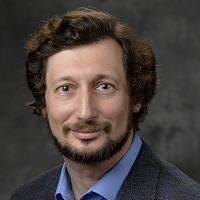News & Events / BME Seminar Series / Past Seminar Speakers / 2017-18Vitaliy Rayz, PhD

BME Seminar Series Winter 2018
Thursday, January 11, 2017 at 4-5 pm
Tech L361
Host: Professor Michael Markl
Assistant Professor of Biomedical Engineering, Purdue University
Flow quantification in intracranial aneurysms: numerical models based on 4D Flow MRI
Cerebral aneurysms are dilatations of arteries feeding the brain that can present a danger of rupture, brain compression, and thrombotic occlusion of downstream vessels. A number of studies demonstrated that progression of cerebral aneurysms is affected by hemodynamic forces. Intra-aneurysmal flow dynamics can be quantified with in vivo MRI velocimetry (4D Flow MRI) or with patient-specific models based on imaging data. The 4D Flow MRI is capable of measuring three-dimensional velocity fields through the cardiac cycle, however its limited spatiotemporal resolution and dynamic velocity range may affect the accuracy of the resulting flow metric. Computational Fluid Dynamics (CFD) can provide superior resolution, but the reliability of the simulations depends on modeling assumptions and uncertainty of the vascular geometries and boundary conditions obtained from the imaging data. In our studies, these alternative flow quantification modalities are used to complement each other in order to reduce errors and improve the accuracy of the flow analysis. In addition, in vitro flow measurements conducted in 3D printed models of the same aneurysmal geometries are used to verify CFD results.
An important advantage of the CFD models is the ability to predict postoperative flow fields that would result from different treatment options. In some cases, when an aneurysm cannot be completely removed from the circulation, it can be treated by altering the flow patterns with either a surgery or a flow-diverting stent. Despite their advantages, such treatments introduce complications related to undesired occlusion of vital branching arteries with thrombus. In this talk, some of the cases where image-based CFD analysis was used to provide valuable information to clinicians will be described. Computational models constructed from MR images of the preoperative vascular geometries and flow boundary conditions were modified in order to simulate flow changes caused by alternative surgeries. Numerical solutions for the flow fields were obtained and transport of a virtual contrast agent was modeled in order to estimate flow residence time and determine postoperative regions prone to thrombus deposition. These results demonstrate the potential of image-based CFD models to provide guidance in diagnostics and treatment of cerebral aneurysms.
Learn more about Professor Vitaliy Rayz and their research here.
